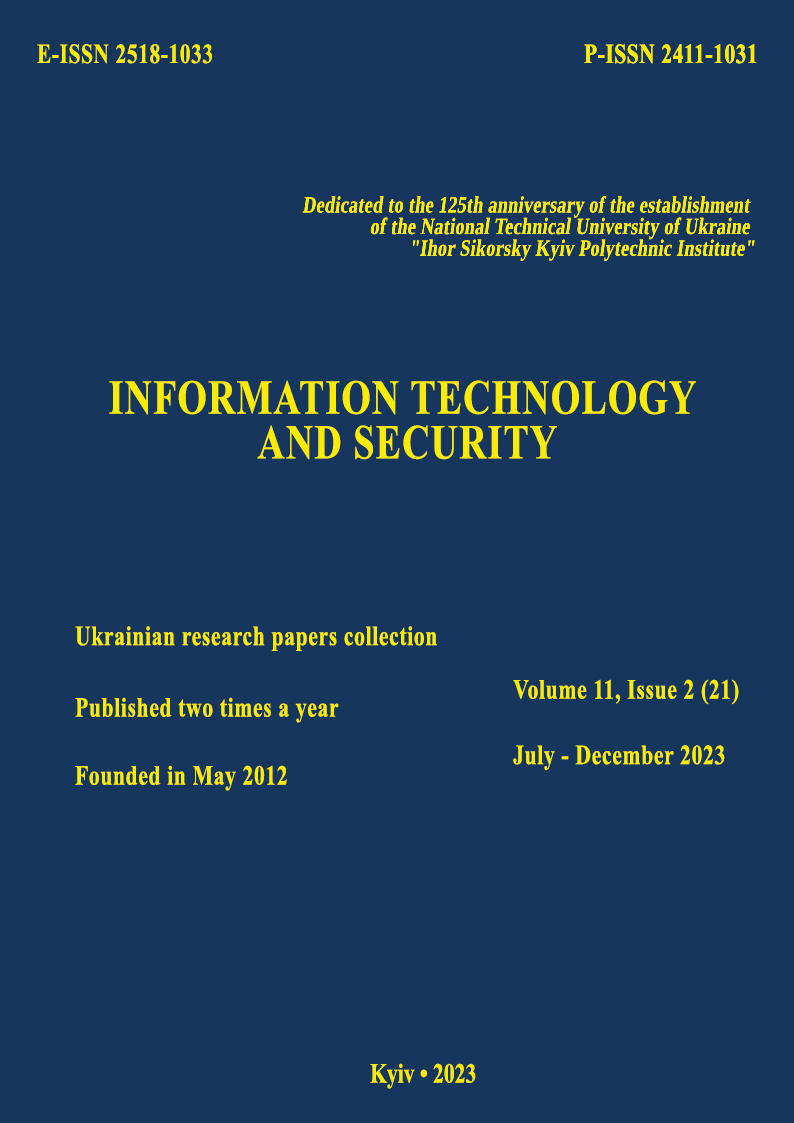Analysis of threats and risks in the Web3 ecosystem in the security context
DOI:
https://doi.org/10.20535/2411-1031.2023.11.2.293824Keywords:
blockchain, vulnerabilities, decentralization, information security, information protection, smart contracts, Web3, NFTAbstract
This research article discusses current and promising issues in the field of cybersecurity, in particular, the analysis of potential threats and risks of Web3 development. Web3 is a new generation of the Internet based on blockchain technology, decentralization, cryptography, and smart contracts. This approach aims to improve security, privacy, and user rights in the virtual environment, but without proper understanding, it can carry the opposite risk. The article begins with an analysis of recent research and issues. The authors discuss potential threats and risks, including possible attacks on decentralization protocols, censorship manipulation, attacks on blockchain protocols, attempts to break the consensus system, and unfair smart contract transactions. The article discusses a number of vulnerabilities and attacks that can harm the new Web 3.0 technology. The article describes new threats to the privacy of users and their digital assets, including the use of anonymization technologies and countermeasures by criminal organizations or government agencies. The article also emphasizes the importance of discussing the legal aspects of Web3 integration, finding an optimal balance between the regulation of the digital space and users' rights to privacy and autonomy. Global challenges require international cooperation and standardization of regulatory rules in this area. The results of the study demonstrate that a conscious approach to analyzing Web3 threats is the key to building a secure future for the Internet. This article contributes to the dissemination of information and knowledge about possible risks, opens up new horizons for scientific research, practical implementation of cybersecurity measures, and political dialogue in the Web3 era.
References
Y. Sompolinsky, and A. Zohar, “Secure high-rate transaction processing in bitcoin”, in Proc. International Conference on Financial Cryptography and Data Security (FC), San Juan, Puerto Rico, 2015, pp. 507-527. doi: https://doi.org/10.1007/978-3-662-47854-7_32.
O. Yashchyk, I. Tverdokhlib, Y. Franko, and M. Ozhha, “Using blockchain technology for security automation of management of educational documents”, Scientific Issues Ternopil Nat. Pedagogical University. Series: Pedagogy, vol. 1, iss. 2, pp. 113-120, 2023. doi: https://doi.org/10.25128/2415-3605.22.2.14.
H. Hevko, O. Yashchyk, T. Savchyn, and L. Hiltai, “Cyber security in decentralized web 3.0 internet ecosystem”, Scientific Issues Ternopil Nat. Pedagogical University. Series: Pedagogy, vol. 1, iss. 1, pp. 61-68, 2023. doi: https://doi.org/10.25128/2415-3605.23.1.8.
K. Nekit, “Advantages and disadvantages of smart-contracts as the basis for the emergence of ownership”, Nat. Tech. Univ. Ukraine Journal. Political Science. Sociology. Law, vol. 3, iss. 47, pp. 101-105, 2020, doi: https://doi.org/10.20535/2308-5053.2020.3(47).229494.
M. Ragnedda, and G. Destefanis, Blockchain and Web 3. 0: Social, Economic, and Technological Challenges. Abingdon, UK: Taylor & Francis Group, 2019.
“Cybersecurity in web 3.0: A new way of protecting systems”, Strike: Continuous Security & Pentesting. [Online]. Available: https://strike.sh/blog/web3.0-cybersecurity. Accessed on: Aug. 19, 2023.
“Smart contract security challenges”, Web3 University – Your Guide to Blockchain Development. [Online]. Available: https://www.web3.university/tracks/create-a-smart-contract/smart-contract-security-challenges. Accessed on: Sep. 19, 2023.
J. Groopman, “Web 3.0 security risks: What you need to know”, TechTarget. [Online]. Available: https://www.techtarget.com/searchsecurity/tip/Top-3-Web3-security-and-business-risks. Accessed on: Sep. 19, 2023.
K. Huang, and W. Ma, Blockchain and Web3: Building the Cryptocurrency, Privacy, and Security Foundations of the Metaverse. Hoboken, NJ, USA: Wiley & Sons, 2022.
Ethereum. [Online]. Available: https://ethereum.org/uk. Accessed on: Sep. 19, 2023.
“Security on the Web3: Best Practices for a Privacy-Driven Future”, Binance Blog. [Online]. Available: https://www.binance.com/uk-UA/blog/ecosystem/безпека-у-web3-найкращі-практики-для-майбутнього-орієнтованого-на-конфіденційність-3731431418476279097. Accessed on: Sep. 19, 2023.
R. Browne, “Web inventor Tim Berners-Lee wants us to 'ignore' Web3: 'Web3 is not the web at all’”, CNBC. [Online]. Available: https://www.cnbc.com/2022/11/04/web-inventor-tim-berners-lee-wants-us-to-ignore-web3.html. Accessed on: Sep. 19, 2023.
N. Ivanenko, “Tim berners-lee calls cryptocurrency “dangerous” and compares it to gambling”, Mezha.Media. [Online]. Available: https://mezha.media/en/2023/02/20/tim-berners-lee-calls-cryptocurrency-dangerous-and-compares-it-to-gambling. Accessed on: Sep. 19, 2023.
J. J. DeLuccia, The NFT & Crypto Currency Security Guide: Must Have Knowledge to Navigate, Purchase, Own, and Trade in the World of Cryptocurrency. Independently published, 2022.
G. Radelchuk, and M. Khoroshun, “Concepts of designing a decentralized payment system with its own digital currency based on the ethereum blockchain platform”, Bulletin of KhNU. Technical of science, vol. 1, iss. 4, pp. 89-93, 2020. doi: https://doi.org/10.31891/2307-5732-2020-287-4-89-93.
P. Kravchenko, B. Skryabin, and O. Dubinina. Blockchain and decentralized systems, Kharkiv, Ukraine: PROMART, 2020.
P. de Filippi, and A. Wright, “Blockchain and the law: The rule of code”, Cambridge, Mass, USA: Harvard University Press, 2018, doi: https://doi.org/10.1111/1468-2230.12459.
R. Taş, “Smart contract security vulnerabilities”, Erzincan University Journal of Science and Technology, vol. 16, iss. 1, pp. 196-211, 2023. doi: https://doi.org/10.18185/erzifbed.1105551.
“Social networks have turned artificial intelligence into a brat and a racist”, Correspondent.net. [Online]. Available: https://ua.korrespondent.net/lifestyle/3656008-sotsmerezhi-zrobyly-zi-shtuchnoho-intelektu-khama-i-rasysta. Accessed on: Sep. 23, 2023.
Downloads
Published
How to Cite
Issue
Section
License
Copyright (c) 2023 Collection "Information Technology and Security"

This work is licensed under a Creative Commons Attribution 4.0 International License.
The authors that are published in this collection, agree to the following terms:
- The authors reserve the right to authorship of their work and pass the collection right of first publication this work is licensed under the Creative Commons Attribution License, which allows others to freely distribute the published work with the obligatory reference to the authors of the original work and the first publication of the work in this collection.
- The authors have the right to conclude an agreement on exclusive distribution of the work in the form in which it was published this anthology (for example, to place the work in a digital repository institution or to publish in the structure of the monograph), provided that references to the first publication of the work in this collection.
- Policy of the journal allows and encourages the placement of authors on the Internet (for example, in storage facilities or on personal web sites) the manuscript of the work, prior to the submission of the manuscript to the editor, and during its editorial processing, as it contributes to productive scientific discussion and positive effect on the efficiency and dynamics of citations of published work (see The Effect of Open Access).

